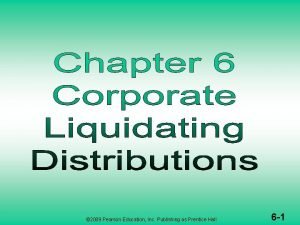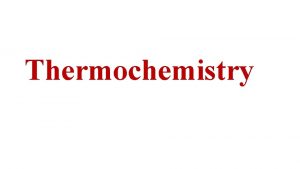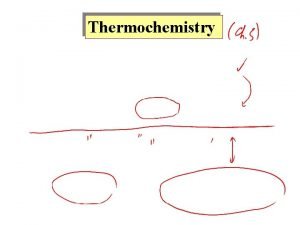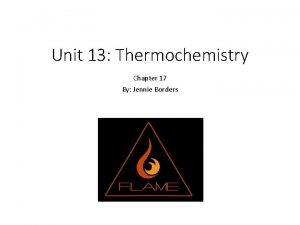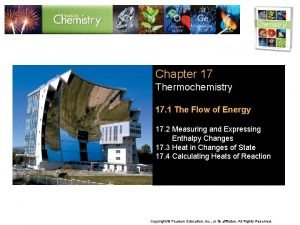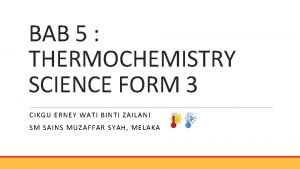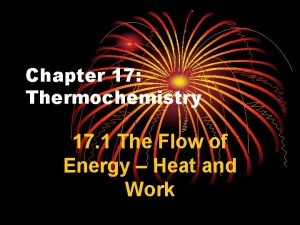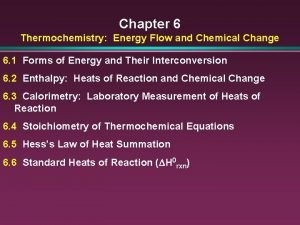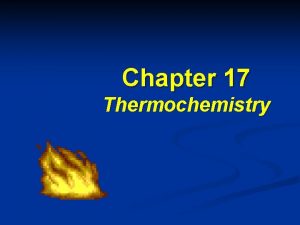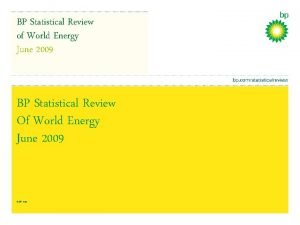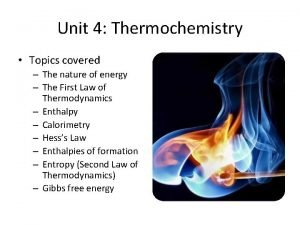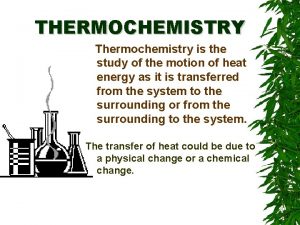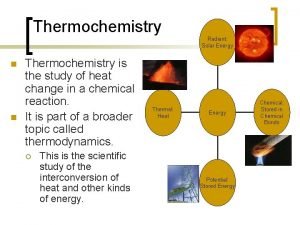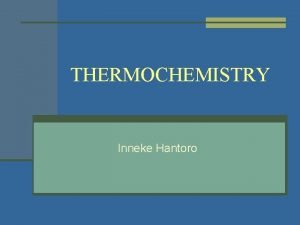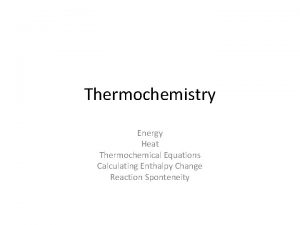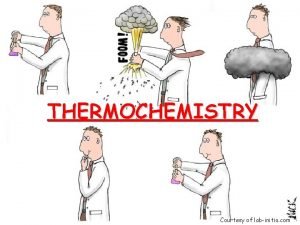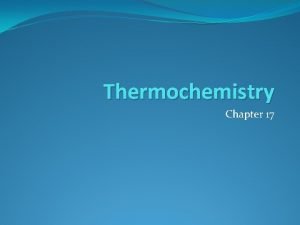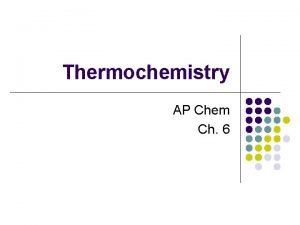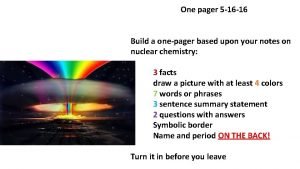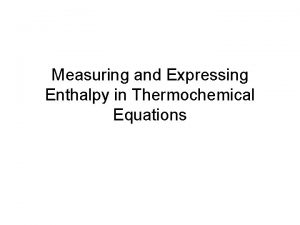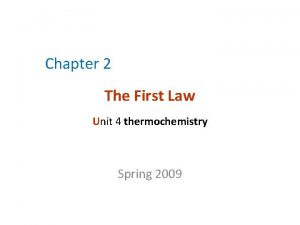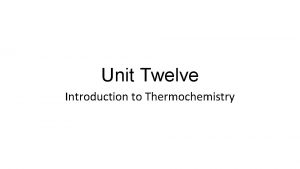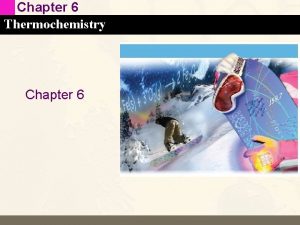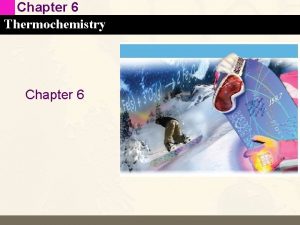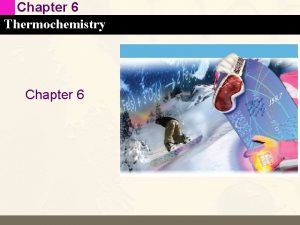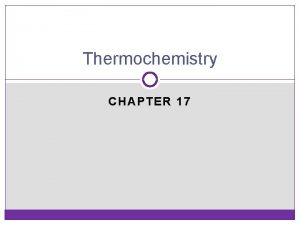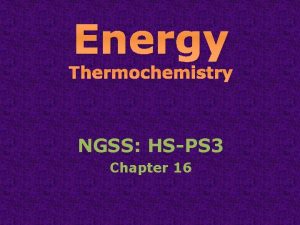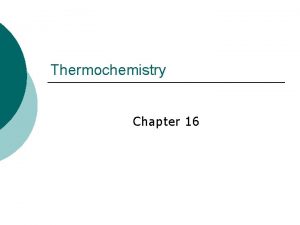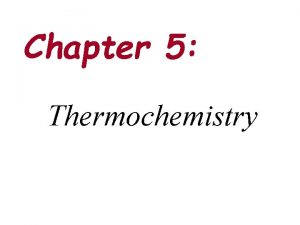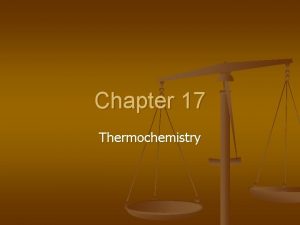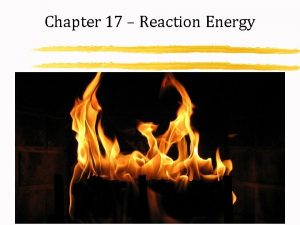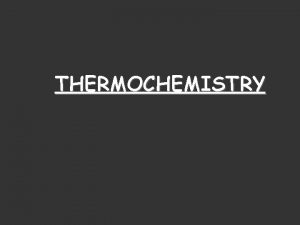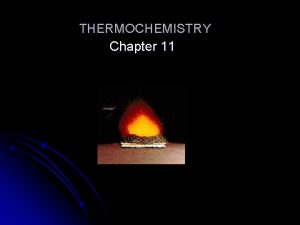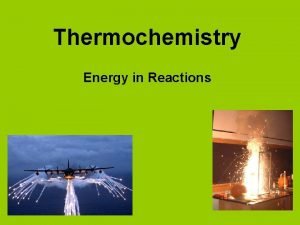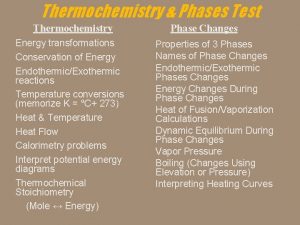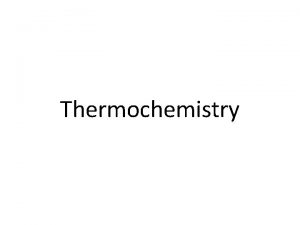Chapter Thermochemistry 2009 PrenticeHall Inc Energy Energy is


































- Slides: 34

Chapter Thermochemistry © 2009, Prentice-Hall, Inc.

Energy • Energy is the ability to do work or transfer heat. – Energy used to cause an object that has mass to move is called work. – Energy used to cause the temperature of an object to rise is called heat. Thermochemistry © 2009, Prentice-Hall, Inc.

Definitions: Work • Energy used to move an object over some distance is work. • w=F d where w is work, F is the force, and d is the distance over which the force is exerted. Thermochemistry © 2009, Prentice-Hall, Inc.

Potential Energy Potential energy is energy an object possesses by virtue of its position or chemical composition. Thermochemistry © 2009, Prentice-Hall, Inc.

Kinetic Energy Kinetic energy is energy an object possesses by virtue of its motion. 1 KE = mv 2 2 Thermochemistry © 2009, Prentice-Hall, Inc.

Heat • Energy can also be transferred as heat. • Heat flows from warmer objects to cooler objects. Thermochemistry © 2009, Prentice-Hall, Inc.

Units of Energy • The SI unit of energy is the joule (J). kg m 2 1 J = 1 s 2 • An older, non-SI unit is still in widespread use: the calorie (cal). 1 cal = 4. 184 J Thermochemistry © 2009, Prentice-Hall, Inc.

Conversion of Energy • Energy can be converted from one type to another. • For example, the cyclist above has potential energy as she sits on top of the hill. Thermochemistry © 2009, Prentice-Hall, Inc.

Conversion of Energy • As she coasts down the hill, her potential energy is converted to kinetic energy. • At the bottom, all the potential energy she had at the top of the hill is now kinetic energy. Thermochemistry © 2009, Prentice-Hall, Inc.

First Law of Thermodynamics • Energy is neither created nor destroyed. • In other words, the total energy of the universe is a constant; if the system loses energy, it must be gained by the surroundings, and vice versa. Thermochemistry © 2009, Prentice-Hall, Inc.

Definitions: System and Surroundings • The system includes the molecules we want to study (here, the hydrogen and oxygen molecules). • The surroundings are everything else (here, the cylinder and piston). Thermochemistry © 2009, Prentice-Hall, Inc.

Internal Energy The internal energy of a system is the sum of all kinetic and potential energies of all components of the system; we call it E. Thermochemistry © 2009, Prentice-Hall, Inc.

Internal Energy By definition, the change in internal energy, E, is the final energy of the system minus the initial energy of the system: E = Efinal − Einitial Thermochemistry © 2009, Prentice-Hall, Inc.

Changes in Internal Energy • If E > 0, Efinal > Einitial – Therefore, the system absorbed energy from the surroundings. – This energy change is called endergonic. Thermochemistry © 2009, Prentice-Hall, Inc.

Changes in Internal Energy • If E < 0, Efinal < Einitial – Therefore, the system released energy to the surroundings. – This energy change is called exergonic. Thermochemistry © 2009, Prentice-Hall, Inc.

Changes in Internal Energy • When energy is exchanged between the system and the surroundings, it is exchanged as either heat (q) or work (w). • That is, E = q + w. Thermochemistry © 2009, Prentice-Hall, Inc.

E, q, w, and Their Signs Thermochemistry © 2009, Prentice-Hall, Inc.

Exchange of Heat between System and Surroundings • When heat is absorbed by the system from the surroundings, the process is endothermic. Thermochemistry © 2009, Prentice-Hall, Inc.

Exchange of Heat between System and Surroundings • When heat is absorbed by the system from the surroundings, the process is endothermic. • When heat is released by the system into the surroundings, the process is exothermic. Thermochemistry © 2009, Prentice-Hall, Inc.

Enthalpy At constant pressure, the change in enthalpy is the heat gained or lost. H = q Thermochemistry © 2009, Prentice-Hall, Inc.

Endothermicity and Exothermicity • A process is endothermic when H is positive. Thermochemistry © 2009, Prentice-Hall, Inc.

Endothermicity and Exothermicity • A process is endothermic when H is positive. • A process is exothermic when H is negative. Thermochemistry © 2009, Prentice-Hall, Inc.

Enthalpy of Reaction The change in enthalpy, H, is the enthalpy of the products minus the enthalpy of the reactants: H = Hproducts − Hreactants Thermochemistry © 2009, Prentice-Hall, Inc.

Enthalpy of Reaction This quantity, H, is called the enthalpy of reaction, or the heat of reaction. Thermochemistry © 2009, Prentice-Hall, Inc.

The Truth about Enthalpy 1. Enthalpy is an extensive property. 2. H for a reaction in the forward direction is equal in size, but opposite in sign, to H for the reverse reaction. 3. H for a reaction depends on the state of the products and the state of the reactants. Thermochemistry © 2009, Prentice-Hall, Inc.

Calorimetry Since we cannot know the exact enthalpy of the reactants and products, we measure H through calorimetry, the measurement of heat flow. Thermochemistry © 2009, Prentice-Hall, Inc.

Heat Capacity and Specific Heat The amount of energy required to raise the temperature of a substance by 1 K (1 C) is its heat capacity. Thermochemistry © 2009, Prentice-Hall, Inc.

Heat Capacity and Specific Heat We define specific heat capacity (or simply specific heat) as the amount of energy required to raise the temperature of 1 g of a substance by 1 K. Thermochemistry © 2009, Prentice-Hall, Inc.

Heat Capacity and Specific Heat Specific heat, then, is heat transferred Specific heat = mass temperature change q C p= m T Thermochemistry © 2009, Prentice-Hall, Inc.

Constant Pressure Calorimetry By carrying out a reaction in aqueous solution or transferring a hot metal in a simple calorimeter such as this one, one can indirectly measure the heat change for the system by measuring the heat change for the water in the calorimeter. Thermochemistry © 2009, Prentice-Hall, Inc.

Constant Pressure Calorimetry Because the specific heat for water is well known (4. 184 J/g-K), we can measure H for the reaction with this equation: q = m Cp T Thermochemistry © 2009, Prentice-Hall, Inc.

Bomb Calorimetry • Reactions can be carried out in a sealed “bomb” such as this one. • The heat absorbed (or released) by the water is a very good approximation of the enthalpy change for the reaction. Thermochemistry © 2009, Prentice-Hall, Inc.

Energy in Foods Most of the fuel in the food we eat comes from carbohydrates and fats. Thermochemistry © 2009, Prentice-Hall, Inc.

Energy in Fuels The vast majority of the energy consumed in this country comes from fossil fuels. Thermochemistry © 2009, Prentice-Hall, Inc.
 2009 pearson education inc
2009 pearson education inc 2009 pearson education inc
2009 pearson education inc 2009 pearson education inc
2009 pearson education inc Copyright 2009
Copyright 2009 Copyright 2009 pearson education inc
Copyright 2009 pearson education inc 2009 pearson education inc
2009 pearson education inc Copyright 2009 pearson education inc
Copyright 2009 pearson education inc 2009 pearson education inc
2009 pearson education inc Copyright 2009 pearson education inc
Copyright 2009 pearson education inc Copyright 2009 pearson education inc
Copyright 2009 pearson education inc 2009 pearson education inc
2009 pearson education inc Energy diagram thermochemistry
Energy diagram thermochemistry Kinetic energy thermochemistry
Kinetic energy thermochemistry Chapter 17 thermochemistry practice problems
Chapter 17 thermochemistry practice problems Chapter 17 thermochemistry
Chapter 17 thermochemistry Chapter 17 thermochemistry answer key
Chapter 17 thermochemistry answer key Science textbook form 3
Science textbook form 3 Quiz 2: heat flow and technology
Quiz 2: heat flow and technology Chapter 6 thermochemistry
Chapter 6 thermochemistry Chapter 17 thermochemistry
Chapter 17 thermochemistry Bp statistical review of world energy 2009
Bp statistical review of world energy 2009 Gibbs free energy unit
Gibbs free energy unit Thermochemistry is the study of *
Thermochemistry is the study of * Thermochemistry is study of
Thermochemistry is study of Thermochemical equation
Thermochemical equation Thermochemistry
Thermochemistry Thermochemistry gaussian
Thermochemistry gaussian Thermochemical equation
Thermochemical equation Thermochemistry cartoon
Thermochemistry cartoon Chemistry semester 2 review unit 12 thermochemistry
Chemistry semester 2 review unit 12 thermochemistry Thermochemistry is the study of
Thermochemistry is the study of Thermochemistry equations
Thermochemistry equations Thermochemistry one pager
Thermochemistry one pager Thermochemistry equations
Thermochemistry equations Kirchhoff's law enthalpy example
Kirchhoff's law enthalpy example

